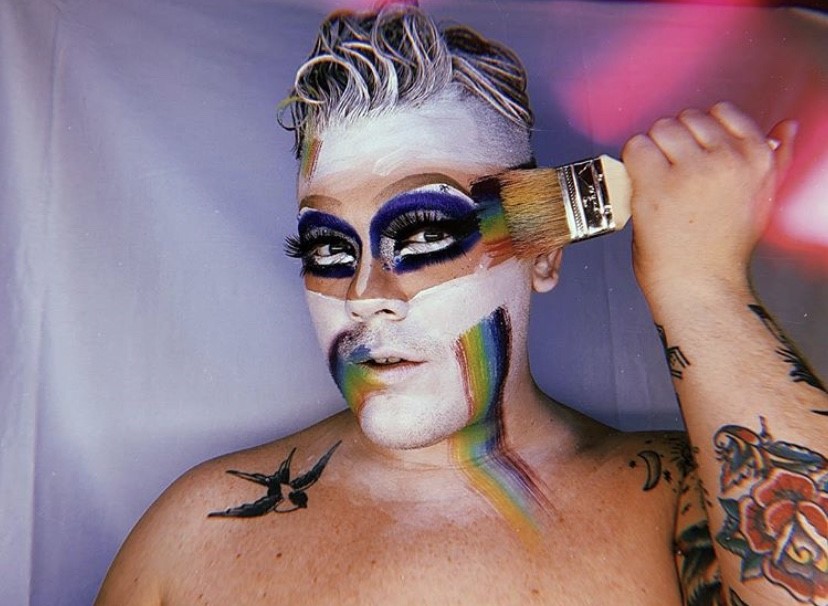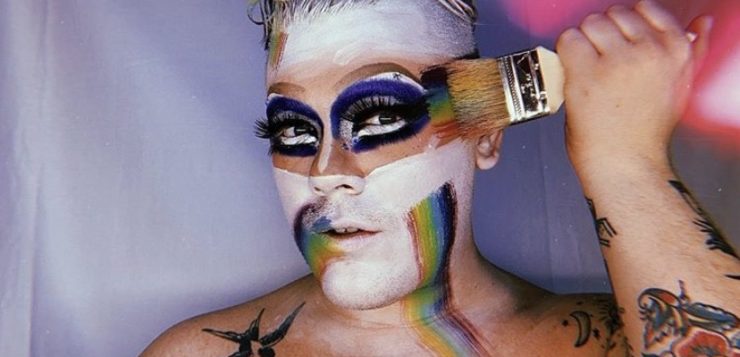
Maxine is a powerful, blue-eyed drag queen. She walks down the street—full swagger—and no one protests. Bigots damn near smile—and let her go on her merry way. And this, my friends, points to the dire social issues in America.
Imagine a national seamstress of sorts, doling out costumes. It may seem unlikely that a black football star and a white drag queen’s hot pants are cut from the same cloth, but shimmy into your spandex and follow me.
Boston-born Justin Cimon is a 24-year-old manager at Whole Foods in Woburn, Massachusetts, and drag queen extraordinaire. He explains to me the evolution of Maxine, his drag persona, over Irish coffees one rainy night. We sip and laugh, and I marvel at his strength and confidence as he guides me through a crash course in all things drag. We dabble in politics (RuPaul), filmography (John Waters and Divine), and the expense of glam. Justin reveals just a glimpse of his pain as a gay man—loosens the top button just enough—a tease, a little peek. But the money shot he reserves for the art itself: the art of drag.
I know that to be an ally, advocate, or accomplice to the marginalized, I need to step out of my comfort zone. I put myself under Justin’s tutelage: “Tell me everything I need to know about drag.” Gracious and genuine, he walks me through his childhood dreams of being a performer.
As if awash in an Instagram filter, Justin’s exuberance seems to emanate from him like perfectly curated champagne bubbles as he describes magic shows that he and his sister would perform for Mom and Dad. Palpable as well, though, is the pain of a young gay boy who found empowerment in his mother’s clothes closet: “The kids were horrible. They. Were. Horrible.”
Grateful that he was never physically abused, Justin has nevertheless had to develop life skills to navigate the verbal punches and unspoken assaults that society wails endlessly upon his gay body.
High school theater productions fueled his artistic calling—and also offered his earliest experiences with makeup. He first found the courage to go out publicly in drag on June 30, 2011, attending a Scissor Sisters concert when he was about sixteen years old. He laughs as he explains how basic his outfit and makeup were: a Forever 21 dress, luxe lashes, and Chapstick, his nervousness held in check by freedom, relief, and empowerment.
Along the way, Maxine was born one Halloween. Maxine calls to mind John Waters’ famed drag queen Divine. As Justin describes her—he leans in a bit, an actual sparkle in his eye: “She’s more glamorous than I am—sassy, witty, and all over the place!” Maxine borrows a bit of the horror theme of the 1960s Divine, so faux blood is as prominent an accessory as lashes and wigs. “Divine was so freaky. It just provides a different perspective.” In fact, different perspectives are at the heart of drag, an art born in the study of duality: “You put your art out there, and people either love it, or they don’t.”
Well, most people love it. Not only has RuPaul’s Drag Race been a smash hit over the years—propelling drag culture into the mainstream (and network profitability)—but Justin says he is rarely if ever harassed when he’s in public as Maxine. And here’s where that duality
comes into play again, though this time it creeps up and smacks a queen on the ass and says, “Great show.”
It probably was a great show. So what’s the problem, you might ask?
The problem—the thing that has kept me awake so many nights since Justin and I communed over Irish coffees—is that Maxine is cheered and applauded, whereas Justin has to steady himself against random outcries of “Fag!” as he walks down the street. The problem is that often society masks the marginalized for entertainment—and profit.
Maxine, as fabulous as she is (and trust me, honey, she is magnificent), is often more welcomed in the mainstream because she’s entertaining. On the one hand, this is exceptionally empowering for Justin and anyone exploring the art of drag culture (drag queens, drag kings, trans-queens, etc.). Bringing this art to the larger concentric circles of society is beneficial in countless ways, both to the artist and to the consumer of the art. I cannot stress this point enough: this exchange of culture is crucial and helps to move us forward as a human community. But we cannot turn a blind eye to the corrosive duality that lies within: this willingness to consume the masked, marginalized culture for entertainment and profit, but not the authentic gay person beneath.
Swap the teased out wig for a football helmet, and you’ll find that Maxine and Colin Kaepernick are both of the masked marginalized community, both cheered and celebrated—so long as they don’t unmask in public; so long as they don’t reveal themselves and lay claim fully to their otherwise oppressed experiences; so long as they don’t use their given platform to speak up—speak out.
Kenneth Sean Chaplin and Jeffrey Montez de Oca, on the heels of Colin Kaepernick’s racial injustice protests (kneeling during the national anthem at NFL games), spoke to this point in a recent article on The Society Pages website. Their study points out that some of the study participants “argued that players had an obligation to provide them with uninterrupted entertainment.” The authors contend that study participants expressed an “overall lack of regard for Black Americans’ lives, and their desire to be entertained by Black athletic bodies. [And] found market relations empowered white fans to adore black athletes on the condition that these athletes never challenge their consumer pleasures by drawing attention to the realities of institutional racism.”
In an e-mail exchange in which Dr. Chaplin and I began to explore the idea of the complex socioeconomic impact of mainstream consumption of entertainment brought forth by marginalized people and cultures, he commented that “many of these peoples are routinely castigated politically via a mixture of personal [and]social [factors]and mass media. Drag and many other marginal social justice movements are also routinely commercialized and commodified.”
At this intersection of consumption and truth, we find some of our most timely and important platforms: catwalks and football fields alike. Entertainment is an amalgam of authenticity and invention presented by an artist’s lived experience—some majestic slurry of their joy, pain, and dedication. To consume their art and the glory of their athletic achievements without regard for their experience is like honoring Gandhi by hosting a cheeseburger festival.
It sounds ridiculous, yet day after day we gobble-up bite-sized morsels of entertainment from the masked and marginalized, pulling our piggish snouts from the trough only as necessary to subdue their voices with either hate or ignorance.
But there is no Maxine without Justin. He is both muse and muster; he is the well from which Maxine draws her intoxicating power—and quenches our thirst. As with many great artists, Justin’s fuel is buried deep within his experience of both elation and despair. To warm ourselves in the combustion of his life journey, as Maxine struts her stuff, mandates that we name that energy source fully by removing the mask and allowing Maxine to share the spotlight with Justin’s experiences.
 Melanie Carden is a Boston-based writer and editor. Formerly a newspaper columnist, she writes about social justice, culture, cooking, and food sovereignty. She earned her BA in Food and Culture Journalism (Summa Cum Laude) from UMass Amherst (University Without Walls program). Mel can’t resist a good coffee mug and is obsessed with picnics. Her website is Melaniecarden.com.
Melanie Carden is a Boston-based writer and editor. Formerly a newspaper columnist, she writes about social justice, culture, cooking, and food sovereignty. She earned her BA in Food and Culture Journalism (Summa Cum Laude) from UMass Amherst (University Without Walls program). Mel can’t resist a good coffee mug and is obsessed with picnics. Her website is Melaniecarden.com.






